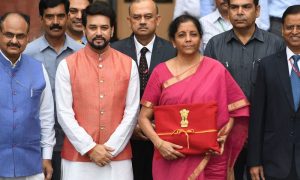
06-07-2019 (Important News Clippings)
To Download Click Here.
 Date:06-07-19
Date:06-07-19
Up In The Air
Nirmala Sitharaman’s Budget pitches for large foreign investment. But details have to be fleshed out
TOI Editorials

Finance minister Nirmala Sitharaman’s first Budget is constructed with an overarching goal in mind: A $5 trillion economy by 2024-25. This requires an annual growth of 8% which will have to come on the back of a surge in investment. The Budget’s salient message is that the Narendra Modi government is going to roll out the red carpet for foreign investment in pursuit of its goal. Consequently, key sections of the speech focussed on plans for the capital market. They include debt market reform to encourage foreign and domestic investment, higher FDI limits and looser restrictions on FII investment. Crucially, Sitharaman announced that government will for the first time look at the option of foreign borrowing to bridge its deficit. Strategic disinvestment is also back on the agenda.
This path will increase RBI’s challenges. Its relationship with government seems to have improved as it has now been entrusted with greater regulatory power over NBFCs. Housing finance companies have again been brought into its supervisory control. Most of these ideas are still on the drawing board and much will depend on the regulatory fine print. A related development is that NBFCs, a crucial channel to fund consumption and investment, will get a fiscal boost to tide over their liquidity problems.
The tax proposals are underwhelming. A small step was taken to lower the headline corporate tax rate to 25%. Companies with a turnover of upto Rs 400 crore, representing 99.3% of base, have been brought into this category. These tentative steps are inconsistent with the goal of attracting large investments in manufacturing. The economy will be better off with a faster transition to lower rates and a phase out of exemptions. This will be a better bet to bring in global companies with the means to establish mega-manufacturing plants in high technology – the Budget instead opted for tax concessions under a special scheme. On the customs duty side, there were a series of tariff increases to promote domestic manufacturing. These tax policies lack coherence given the goal of integrating Indian manufacturing into global value chains. In addition Sitharaman went back to raising indirect taxes on petrol and diesel, likely to have an inflationary impact.
The two areas where direct tax policy had clear intent was the use of concessions in personal income tax to promote affordable housing and electric vehicles. Construction has a knock-on effect on many industries and this measure will help mitigate the economic slowdown. Government wants India to capitalise on the inevitable advent of EVs in the mass market. This is where the real challenge comes in. If a fiscal stimulus on the demand side is to also boost local manufacturing, states must work with the Centre to reform factor markets such as land and labour.
The Budget arithmetic rests on a forecast of a 12% growth of nominal GDP in 2019-20 to Rs 211 trillion. It’s expected to translate into a modest 9.5% growth in tax collections. The total expenditure is budgeted to increase by 13% to Rs 27.86 trillion. Given NDA’s willingness to borrow abroad, it’s time to take a closer look at the budgetary support coming through public sector enterprises. It’s an unhealthy trend that’s on the rise. Since overseas borrowing or a possible windfall through transfer of RBI reserves are not accounted, meeting the estimated fiscal deficit target of 3.3% is a foregone conclusion. However, the quality of fiscal consolidation does remain worrisome.
On balance, the Budget does show clearly that the way forward is to attract foreign savings and investment. However, there isn’t much by way of a coherent fiscal policy. Actualisation of these plans will depend on regulatory details and harmonious federalism.
अमेरिका-ईरान तनाव से दुविधा में फंसता भारत
टीसीए राघवन, डायरेक्टर जनरल, इंडियन कौंसिल ऑफ वर्ल्ड अफेयर्स

अमेरिका और ईरान में कोई पहली बार टकराव नहीं बढ़ा है, मगर इसका यह अर्थ भी नहीं कि मौजूदा तनाव से दोनों देशों के साथ-साथ इस क्षेत्र और अन्य देशों को नुकसान कम होगा। होर्मुज जलडमरूमध्य से होकर हाइड्रोकार्बन गुजरता है, और जब-जब अमेरिका तथा ईरान के रिश्ते खट्टे हुए हैं, फारस या अरब की खाड़ी चिंता की स्थाई वजह बनी है। बहरहाल, ईरान द्वारा तेल टैंकरों पर हमले करने या उकसाने के अमेरिकी आरोप, अतिरिक्त नौसेना की तैनाती की वाशिंगटन की घोषणा और ईरान द्वारा पायलट रहित अमेरिकी विमान को मार गिराने के बाद से यहां के हालात अधिक तनावपूर्ण हो गए हैं।
अमेरिका और ईरान के बीच तनाव का यह नया दौर दरअसल उसी कड़ी का हिस्सा है, जिसका शुरुआती सिरा वॉशिंगटन द्वारा ‘ज्वॉइंट कॉम्प्रिहेंसिव प्रोग्राम ऑफ एक्शन’ (जेसीपीओए) से पीछे हटना था। 14 जुलाई, 2015 को इस संयुक्त व्यापक कार्ययोजना पर ईरान और पी 5+1 देश (चीन, फ्रांस, रूस, अमेरिका, ब्रिटेन और जर्मनी) सहमत हुए थे। यह अमेरिका और ईरान के ऐतिहासिक दोषपूर्ण रिश्तों को सुधारने का एक उच्चतम प्रयास था। समझौते के तहत ईरान ने अपने परमाणु कार्यक्रम और उससे जुड़ी गतिविधियों को सीमित करने की प्रतिबद्धता जताई थी, जिसके बदले में अमेरिका ने भी उस पर लगे प्रतिबंधों में ढील दी थी। दोनों मुल्कों में उदारवादी लोग कट्टरपंथियों पर हावी हो गए थे। मगर नए अमेरिकी राष्ट्रपति के तौर पर डोनाल्ड ट्रंप की ताजपोशी के बाद स्थिति बदल गई। मई, 2018 में जेसीपीओए से बाहर निकलने और ईरान पर फिर से प्रतिबंध लगाने का उनका फैसला संबंध सुधारने के इन तमाम प्रयासों पर आखिरी चोट साबित हुआ।
अमेरिका और सऊदी अरब-इजरायल जैसे उसके मित्र-राष्ट्रों की नजरों में क्षेत्रीय स्थिरता तभी आ सकती है, जब ईरान की ताकत स्वीकार्य सीमा तक सीमित रहे। जबकि ईरानी नेतृत्व के लिए मौजूदा स्थिति सिर्फ उन दबावों की पुनरावृत्ति है, जिससे वह 1979 से जूझता रहा है। यह दवाब उन क्षेत्रीय और गैर-क्षेत्रीय देशों का है, जो आपस में मिलकर ईरानी क्रांति के लाभ को कमतर करने की कोशिशों में लगे रहे हैं। अमेरिका और उसके मित्र-राष्ट्र मानते हैं कि लेबनान में हिज्बुल्लाह की मजबूती, अरब दुनिया में बीती सदी में एक प्रमुख शिया देश का उदय (इराक), सत्ता परिवर्तन के लिए बनाए गए दबाव का (रूस की मदद से) सीरिया द्वारा प्रतिरोध और यमन में सऊदी अरब का सबसे लंबा सैन्य हस्तक्षेप अरब दुनिया में ईरान के बढ़ते प्रभाव का नतीजा है। हालांकि ईरान को ये सभी भू-राजनीतिक लाभ उसके खिलाफ दृढ़ विरोध के कारण मिलते रहे। इसके अलावा, यह अमेरिका व उसके मित्र-राष्ट्रों की नीतिगत विफलता या गलत फैसले का भी नतीजा रहा।
ट्रंप की नजर में जेसीपीओए नाकाफी प्रयास था और ईरान द्वारा अपने परमाणु हथियार कार्यक्रम के लिए प्रौद्योगिकी के दोहन की क्षमता तेहरान के नेतृत्व वाले शिया वर्चस्व को अजेय ताकत बना देगी। ईरान के लिए भी मुद्दा इसी तरह सामान्य है- पश्चिम में अमेरिका का प्रभुत्व और दक्षिण-पश्चिम एशिया व ईरान के पारंपरिक दुश्मनों द्वारा इसका इस्तेमाल क्षेत्रीय व्यवस्था तय करने में करना। तेहरान की नजरों में 1979 की क्रांति को स्वीकार करने की वाशिंगटन की अनिच्छा ईरान के हालिया और पहले के संकटों का मूल कारण है। परमाणु समझौते से अमेरिका के एकतरफा बाहर निकल आने ने भी ईरान को उद्वेलित किया है। फिर, अमेरिकी प्रतिबंध ईरान को नुकसान पहुंचा रहे हैं, खासतौर से वाशिंगटन द्वारा ईरान से कच्चे तेल का आयात करने वाले देशों पर प्रतिबंध लगाने का ट्रंप प्रशासन का हालिया फैसला नुकसानदायक है।
भारत के लिए बड़ा सवाल यह है कि इस परिस्थिति में वह अपने हितों की रक्षा कैसे करे। ईरान के साथ अच्छे संबंध बनाए रखना और अपनी ऊर्जा सुरक्षा को प्राथमिकता देना लाजिमी है, लेकिन खाड़ी के देशों और अमेरिका के साथ जुड़े महत्वपूर्ण हितों के साथ इसका संतुलन बनाना भी आवश्यक है। यानी मौजूदा स्थिति देश के लिए दुविधापूर्ण है, क्योंकि अरब सागर के देशों के बीच एक बड़े सहयोगात्मक ढांचे की कमी है, जबकि इस क्षेत्र से हमारे कई महत्वपूर्ण हित जुड़े हैं।
